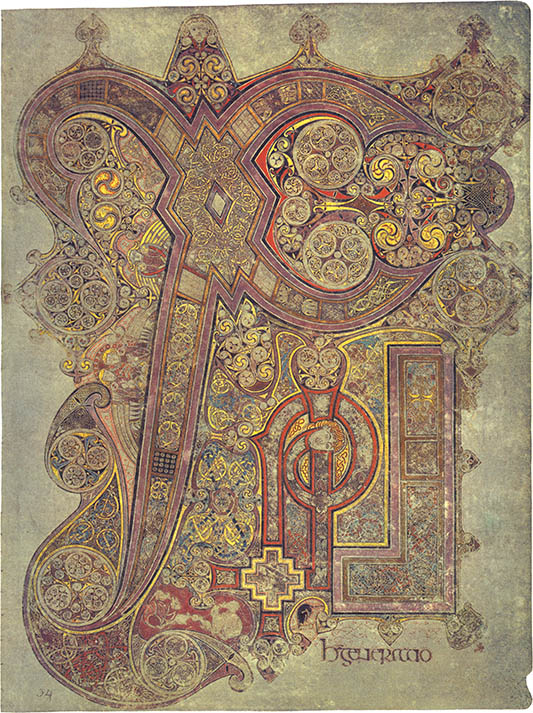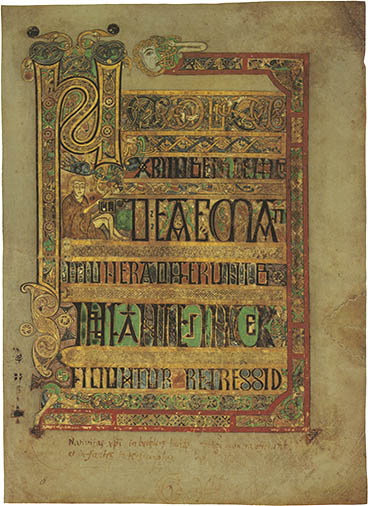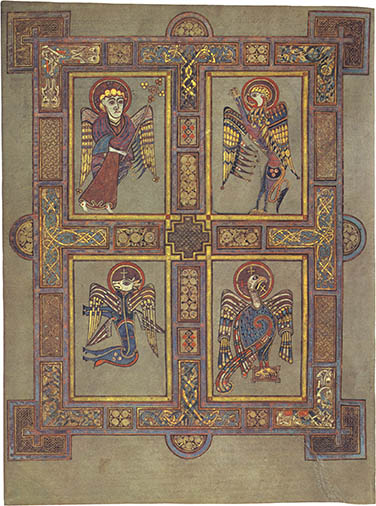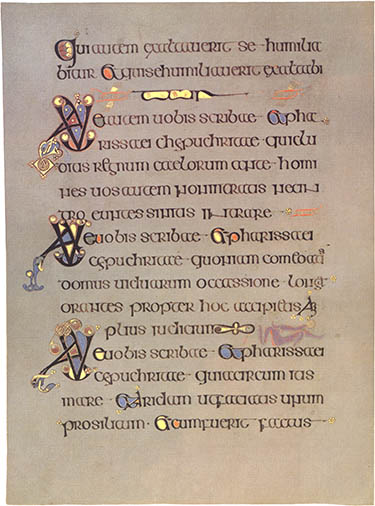Chi-rho. Folio 34, recto
37
The Book of Kells
Insular Majuscule
This is Matthew 1:18 (XPI h generatio – Christi autem generatio), the famous Chi-rho page from the Book of Kells.1 The Book of Kells represents the high-point of Insular art and is perhaps the most celebrated, and studied,2 book of the middle ages. It’s fame rests not on the text – the vulgate version of the gospels – but from its absolutely relentless level of illustration, decoration and illumination. Giraldus Cambrensis, the 13th century historian, described it as “...the work, not of men, but of angels,” and the author Umberto Eco, more recently and perhaps closer to the mark, described it as “the product of a cold-blooded hallucination.”
The manuscript, written around 800 AD, may have been done at the monastery in Iona, Scotland, or in the Abbey of Kells, County Meath, Ireland. Or it may have been started in Iona and finished at Kells, or whatever; but by ca.1000 appears to have been in the possession of the Abbey at Kells. In 1007 The Annals of Ulster states that “the great Gospel of Columkille, the chief relic of the Western World (primh-mind iarthair domain), was wickedly stolen during the night from the western sacristy of the great stone church at Cenannas on account of its wrought shrine.”3 The manuscript was recovered “after two months and twenty nights under a sod.”
The book was certainly in Kells by the 12th century as land charters pertaining to the Abbey were copied onto some of its blank pages. It remained here until 1653–4 when Cromwell’s cavalry was quartered in the church, and the governor of the town, Charles Lambart, sent the book to Dublin for safekeeping. Henry Jones, who became bishop of Meath, presented the manuscript to Trinity College in Dublin in 1661. The book is still in possession of the College and is currently displayed in the Long Room of the Trinity College library.
There is certainly no shortage of scholarly analysis of the books’ illumination, illustration, decoration or iconography, so I’ll just skip that part completely. But I would be seriously remiss if I didn’t at least show some representative samples:
Breves causae of Matthew. Folio 8, recto
The Four Evangelists. Folio 27, verso
Portrait of St. John. Folio 291, verso
Half-uncial or ‘semionciale’ evolved from Roman cursive minuscule, perhaps as early as the third century ad. The script shows a wide rounded a, as well as a rounded stem on the t, and, perhaps most definitively, featured vertical ascenders and descenders that were an integral part of the letter, rather than an accidental pen flourish:

Half-uncial, Rome, ca.600
Half-uncial, while never as widely used as the uncial scripts, nevertheless spread through Continental Europe and reached Ireland around 500 ad. The Hiberno-Saxon scribes modified the half-uncials into a regional style known as Insular script. Over the next 250 years or so Insular majuscule evolved from a script similar to half-uncial into an extremely formal book hand:
The Cathach of St. Columba, ca.625
The Lichfield Gospels, ca.730
By the beginning of the ninth century the script, written with a slightly angled nib, includes generally rounded letters with wide counters, curved uprights on the b, l, and t, and distinctive triangular or wedge-shaped serifs on the ascenders. The script also included many ligatures and scribal abbreviations derived from Tironian notes.
The Book of Kells represents the final, and most accomplished, version of Insular majuscule, It was written by three different scribes (Hands A, B and C) and lightly annotated by several correctors (but honestly could have used a much more systematic proof-reading). The text pages are written with brownish gall-ink in a single column with 18 (or occasionally 19) lines to the page. Perhaps the most notable aspect of the text is the ingenuity in writing. The scribes used many devices to support the illumination, including superscribing letters for ornaments or turning letters sideways at the end of a line (cor fa casan; turn-in-the-path). Here are some examples:
Matthew 23:12–15. Folio 99, verso
Matthew 6:5–10. Folio 45, recto
1. Leabhar Cheanannais (The Book of Kells) (Trinity College Library, MS A. I. 58), AKA the Book of Kelles or Colum Cile (the Book of Columba). The extant manuscript consists of 340 calf vellum folios, cut from bifilios, and sewn into quires of varying sizes (from a single page to 12 folios). It appears that the original manuscript consisted of about 370 folios and the pages measured 370 mm × 260 mm. After several rebindings, including a rather severe one in the 1800s, the pages now measure about 330 mm × 240 mm.
The book now consists of (in order) two fragmentary lists of Hebrew names the Gospels, Breves causae (Gospel summaries), Argumenta (short biographies of the Evangelists), Eusebian canon tables, The Gospels of Matthew, Mark, Luke and John through John 17:13. The four gospels are mostly from the Vulgata with certain passages from the earlier Vetus Latina, typical of insular gospels of the time.
2. The Book of Kells has been shown in illustration since the 1840s. The first complete monograph to include color plates was: Sullivan, E. The Book of Kells. London: The Studio Ltd. 1914. The first systematic facsimile, including both color plates and black and white photos, was: Alton, E.H., et. al. Evangeliorum Quattuor Codex Cenannensis (3 vol). Berne: Urs Graf-Verlag, 1950–51. In 1974 a new facsimile, including all of the full-page illustrations in color, was published as: Henry, F. The Book of Kells: Reproductions from the Manuscript in Trinity College Dublin. London: Thames and Hudson, 1974 (or in the US: Alfred A. Knopf, 1988). The images here were scanned from the Knopf edition. The most recent facsimile, an exact color reproduction of the entire book, was published as: The Book of Kells. Luzern: Faksimile Verlag, 1990. However this limited edition will set you back 18,000 USD. A more affordable alternative, using some of the same images, is: Meehan, B. The Book of Kells. London: Thames and Hudson, 1994 (19.95 USD, list).
3. “The chief relic of the western world” may, of course, have referred to the gold and jeweled ornamental shrine. After all, it was the shrine that was stolen and the book that was recovered. It is theorized that this accounts for the missing beginning and ending folios.
2 Sep 2009 ‧ Typographia Historia







